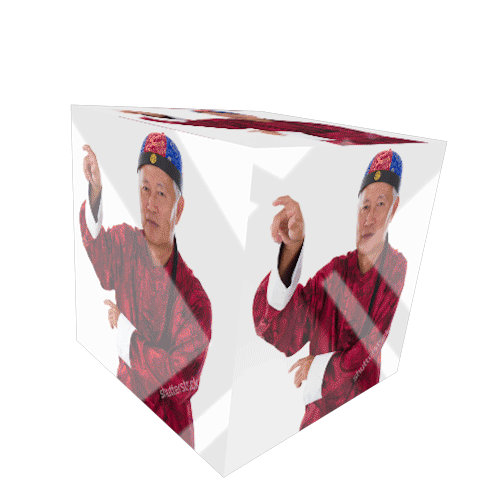🤚Training Core 丹田
2023
Mt. Jade is in Metamorphoses, Script 玉山是一個處理器 / 演出文字記事
How to be a plant 如何變成一棵樹 ◎Shin Hanagata
How to be a Keeper 如何成為管理者 / 守護者 / 監管者 / 維持者 ◎Lin Tzu Ning, Wahcee, Jung Ching Zhou, Zito Tseng, Chan-Kai An, Pusheng Tang
How to live in a Concrete Box 如何於處理器中生存 ◎Sheryl Cheung
Fire Cold Bloom 炙熱與冰冷之間綻放 ◎Wang Yu-Jun
Maze Garden 與蜜喬尼交談——開展為歧路花園的人機劇場 ◎Yang Yu Chiao
3C Xing Yi Quan: Homemaker ◎Xia Lin
Mt. Jade is in Metamorphoses, Script 玉山是一個處理器 / 演出文字記事
How to be a plant 如何變成一棵樹 ◎Shin Hanagata
How to be a Keeper 如何成為管理者 / 守護者 / 監管者 / 維持者 ◎Lin Tzu Ning, Wahcee, Jung Ching Zhou, Zito Tseng, Chan-Kai An, Pusheng Tang
How to live in a Concrete Box 如何於處理器中生存 ◎Sheryl Cheung
Fire Cold Bloom 炙熱與冰冷之間綻放 ◎Wang Yu-Jun
Maze Garden 與蜜喬尼交談——開展為歧路花園的人機劇場 ◎Yang Yu Chiao
3C Xing Yi Quan: Homemaker ◎Xia Lin
2018
3C Xing Yi Quan 3C形意拳 ◎Xia Lin
Virtual Feng Shui Statues 虛擬風水養生雕塑 ◎Fong Han-Yu
We now have mastered the ability to throw stones with empty hand 現在,我們已掌握了空手扔石頭的能力 ◎Eteam
Stream and Download HB/AV Audio Tracks ◎HEAVY BREATHING
Sun’s Shadow ◎Son Ni
Composing the Ordinary ◎Petra Johnson
Elastic Dialogues ◎Xin Cheng & Heidi Salaverria
Upon Unvolutionarily Disappearing ◎Grashina Gabelmann
#AstralSelfie ◎IDPW
Poetic Commentary ◎Zian Chen
3C Xing Yi Quan 3C形意拳 ◎Xia Lin
Virtual Feng Shui Statues 虛擬風水養生雕塑 ◎Fong Han-Yu
We now have mastered the ability to throw stones with empty hand 現在,我們已掌握了空手扔石頭的能力 ◎Eteam
Stream and Download HB/AV Audio Tracks ◎HEAVY BREATHING
Sun’s Shadow ◎Son Ni
Composing the Ordinary ◎Petra Johnson
Elastic Dialogues ◎Xin Cheng & Heidi Salaverria
Upon Unvolutionarily Disappearing ◎Grashina Gabelmann
#AstralSelfie ◎IDPW
Poetic Commentary ◎Zian Chen
With the sporadic sounding of mechanical pulsations,
you travel through the veins of plants to enter a technocratic city and its memory of the future.
Here black water gushes between rock boulders,
while a gust of wind stirs up sand and turns the skyscrapers in front of you into blocks of heated gold.
Multiple commands / archives / information as bodies / decode / generate / natural phenomena
Artificial world / reproduction / resource allocation / functional reorganization / training paths / aggregation
—— ‘Mt. Jade is in Metamorphoses’, Introduction
隨著零星的機器聲響,你在植物的脈動中進入一段都市科技環境的未來記憶,
黑色的水從岩石間的隙縫中涌出,狂風吹起了沙,讓眼前的高樓成了金色,慢慢發燙。
一次提取多個指令 / 檔案 / 資訊身體 / 解碼 / 生成 / 自然現象 /
人造世界 / 生機繁殖 / 調配資源 / 功能重組 / 訓練路徑 / 聚合體
——《玉山是一個處理器》節目介紹節錄
How to be a plant
Shin Hanagata
Before considering how to become a tree, humans may already be trees. They breathe, sense light, and have arms and legs that can move. We have body fluids, tubes that transport nutrients and water, skin where fungi and insects come and create an ecosystem.
But let's get closer to trees.
The Banyan is called the walking tree. It puts its roots down from its branches towards the ground and takes decades to take one step. Try walking slowly like that. Gradually slow down the sense of time.
1: First, walk for about 5 minutes on good soil and take about 3 meters. You can feel the structure of every muscle, bone, and tendon in your body moving. You realize that there is infinite resolution in space. Get closer to trees little by little. Walk for 10 minutes, 1 hour.
a: About grafting. Trees can heal by connecting their branches with their own cross-sections. But it is impossible to heal by connecting the cross-section of a tree and the body of a human. However, try attaching your body to a tree. You will notice the hardness of the tree, how it receives the wind, the sound, smell, and rhythm. Exist accordingly. The branches become hands, the body becomes the trunk, and the tree and the body mix.
2: Slow down further. Take water and walk 3m on the soil taking a day or a week. It is dangerous to fast for more than a week, so you need to get energy by eating soil (there is edible soil called peat).
b: About skin. The tree's skin is very dry. It cracks like atopic dermatitis. To remove the moisture, wash off the surface oil. Apply strong soap or bleach and leave it.
3: It becomes difficult to stand for a long time with human muscles, so you can ask the keepers to put up support poles. If you run out of water and soil you brought, take them from the keepers and walk 3m over the course of 1 month, 6 months, or a year. The movements of the people around you gradually appear faster than you can sense. You lose your words.
c: About seeds. If you can produce sperm, have the keepers collect it and inject it into another tree with an egg. Or if you have an egg, have the keepers collect sperm from another tree and inject it.
4: Slow down even further. Walk 3m on the soil taking 10 years, 30 years, or 50 years. The keepers also change generations, and the city changes. Friends forget about you. Even the police cannot distinguish whether you are a human or not. But you don't care. There are many trees around, and the day flickers like a strobe light.
d: About photosynthesis. In recent studies, technology has been developed to produce starch from light and carbon dioxide. Furthermore, they reproduce themselves. Cloning has already been successful in monkeys by generating artificial stem cells. All that remains is to wait for the realization of issues such as "human dignity". They are expected to be put into practical use in about one more step of time. Wait a little longer.
5: Eventually, it withers away.
如何變成一棵樹
花形槙
思考如何變成一棵樹之前,人類或許已經是樹。人類能夠呼吸、感知光線,擁有能夠移動的手足。人類有體液,有輸送體液和營養的管道,有細菌與蟲寄生的皮膚,因此足以構成一個生態系。
但是,再讓我們試著更靠近樹吧。
榕樹被稱作「行走的樹」。榕樹由地面向下紮根,行走一步即需要花費數十年。請試想著如榕樹般緩慢地行走,漸漸放慢對時間的感受。
1、首先,試著花五分鐘在良好的土壤上行走三公尺。你會感覺到身體每處的肌肉、骨骼和肌腱結構的動作。你會意識到空間的解析度是無限的。你將漸漸地更接近樹木。接著,再花費十分鐘、ㄧ小時行走。
a. 關於嫁接。樹木能夠透過斷面連結樹枝癒合傷口。儘管樹的斷面和人的身體無法癒合,但請試著把自己的身體嫁接於樹。如此一來,樹木的硬度、承風方式、聲音、味道、節奏,都會進入自己的身體。請試著這樣生存——讓樹枝成為手臂,身體成為樹幹,樹與身體合為一體。
2. 再試著放慢一點。帶著水,花上一天、一週在土上行走三公尺。人類節食一週以上是會有危險的,所以你會需要食用土壤來獲取營養(泥炭是可以食用的土壤)。
b. 關於皮膚。樹的皮膚非常乾燥,猶如異味性皮膚炎般龜裂。為了除去皮膚的水分,請把表面的油質洗去,可以使用強鹼肥皂或是漂白水處置。
3. 人類的肌肉難以長時間如此站立,因此可以請KEEPER來提供支撐。當身上的水分、土壤都漸漸流失,便必須從KEEPER獲得養分。請再花費一個月、半年、一年,行走三公尺。漸漸地,你將無法感知周遭人類快速的動作,漸漸失語。
c. 關於種子。若你能夠製造精子,請讓KEEPER取走精子,與卵子結合後注入其他樹木中。若你能夠製造卵子,讓KEEPER注入從其他樹木中獲取的精子。
4. 再試著走得更慢一點。花10年、30年、50年,在土上僅行走三公尺。KEEPER已世代交替,街道也已物換星移。朋友已忘卻你的故事,警察再也無法分辨你是否為人類,但你不在意,周遭有很多樹與你同在,所謂「一天」,將如閃光燈般一瞬而逝。
d.關於光合作用。近日的研究中,透過光和二氧化碳便能生成澱粉。更甚者,能夠自我複製。人工幹細胞的應用已被證實能夠成功產生複製猴,付諸實現之前,必須克服的將是人類尊嚴的課題。
5. 最終枯萎。
Translated by Johan Chang
Photo by Jojo KAO
How to be a Keeper
Movement and Traces/ Searching and Waiting/ Being Aware
The world is Synthesized.
My Relationship with plants reminds me of an older piece of work from myself, “Appropriation”.
“Plants in the garden grew appropriately as a result of the meticulous care of the gardeners”
I read this from a book, and thought to myself: the contrast between natural and artificial circumstances are quite interesting. As a plant growing in human’s reign, what degree of growth could is appropriate?
growing as untrimmed, wild, botanical, is somehow not what it’s supposed to do.
either arranged, potted, or in the wild, in manmade environment under control, or unaltered in the wilderness, house plants, or garments of the city, even untamed forests, can be completely monitored within a space depending on the circumstance or never. Between polarity, how do we treat what we think we can have authority over?
—— How to be a Keeper
◎Lin Tzu Ning
◎Lin Tzu Ning
Let’s keep it that way
Achieving the perfect balance between being in control and letting go while protecting its authenticity. To cultivate, is to show up and to be present, until the foreseen fantasy arrives as the future.
Knowing thyself, as well as seeing it within others, we are one altogether emerging in individuality.
As plants we all grow from soil, and as souls we all come from the same source.
After all, we will rot, transforming into nutrient dense matter for something new to grow on.
—— How to be a Keeper
◎Wahcee
◎Wahcee
The feeling of an idle machine starting once again in a very long time
(but in actuality it is one emotional machinery. yes, ironically, emotional)
The contradicting feeling allows me to acknowledge my own consciousness
sprouting while being and obedient, repetitive device. To attract, obtain and lure in.
Speaking of my relationship with plants, I was reminded an experience that I once had during a performance act.
I took off my shirt and hooked it on a tree as I swung through an arm length gap. We were so close but I still fell through. I didn’t know what to do, so I hugged the tree very tightly. It might sound a bit cliche, but I really enjoyed the tight embrace.
—— How to be a Keeper
◎Jung Ching Zhou
◎Jung Ching Zhou
—— How to be a Keeper
◎Zito Tseng
◎Zito Tseng
—— How to be a Keeper
◎Chan-Kai An
◎Chan-Kai An
Keeper
Incomplete forms of living
as a complete individual
Resembling a creation made by artificial intelligence from foreign matter
What is life?
what is motion, and why?
I am clueless
Just going with a carnal impulse
driven automatically,
I am a module
that exists infinitely
I am as I am
My existence seem to be chance
My plan is not my reason
just happens to be my purpose
an intention in life was then born
- My relationship with plants
A psychic once told me I had a few life times incarnated as trees, specifically cherry blossoms. In this life, I don’t feel a particular connection with plants, every plant except for cactuses died for me. Maybe that explains why I left the plant realm and reincarnated as a human. When I smoke, I look at trees, its leaves, and how they exist. I admire how they stay at the same place, from that I remind myself I can live like that, too. No need to push hard, nor to put in too much effort. Simply just existing as they are.
—— How to be a Keeper
◎Pusheng Tang
◎Pusheng Tang
如何成為管理者 / 守護者 / 監管者 / 維持者
移動 / 軌跡 / 探勘 / 等待 / 覺察
世界是合成的。
與植物的的關係,想到以前做的一個作品《分寸》,
「庭院裡的植物們,因為園丁的照顧而謹守分寸。」
在書上看到這句,覺得其中自然與人為之間的相對很有趣,
在人類領域裡的植物,如何才算謹守分寸?
而未經人為修整而自然生長的植物,又不算是謹守其本分?
插花、植栽、野生,
人為的篩選、人為的控制、自然。
居家植物、都市植栽、野外森林,
空間上,領域內握有掌控權的範圍,
與領域外無完全掌控權之間,
都市與野外的界限劃分與對待的差異性。
我們怎麼對待我們覺得可以掌握的事物?
—— How to be a Keeper
◎林子寧
◎林子寧
Let’s keep it that way
維持它真實的樣貌
取得控制與放任之間的完美平衡
培育: (陪)伴直到抵達(預)見的幻景
肢己枝彼 同時是 也非完全共同體
植栽最原先來自土壤
最終我們也將腐爛成為營養
—— How to be a Keeper
◎Wahcee
◎Wahcee
是被封存的機器,再度被啟動的感覺
(但其實內心是一台感情用事的機器,沒錯,感情用事,有點矛盾)
正是因為這個矛盾,使得自己在不斷地重複自己被下達的命令之後,知道自己有意識的部分慢慢冒出來,去吸引、去抓取、去誘引。
至於我跟植物的關係,想到一個經驗。
有一次在做行為演出的時候,我脫下我身上的襯衫試著想從這邊的崖上勾住旁邊的大樹,想從這邊盪到那邊,然後攀附上面。中間的距離感覺只有五十公分,其實沒有很遠,我們(我和大樹)是靠近的。結果一離地之後我就掉下去了,在場看的人嚇壞了,我也嚇壞了,我卡在樹和山崖的中間,不知道該怎麼辦,然後突然我就緊緊地抱住他不放,擁抱的這個選擇感覺好像是陳腔濫調,但我很喜歡那次的擁抱。
—— How to be a Keeper
◎周蓉靖
◎周蓉靖
Zoo Keeper是一個高中風靡全班的小遊戲。遊戲中,你扮演者一個動物管理員,因應園長命令,在關卡中要不斷挪移和消滅各種指定的動物。過了一關永遠還有下一關。每天我們班上最大的娛樂之一就是在下課的十分鐘,群起興奮地操控動物。當這個職位叫做keeper的遊戲角色在管理動物,也同時正在被遊戲玩家管理著。遊戲玩家也正在被遊戲機制管理者。遊戲機制也正在被遊戲設計師管理者。遊戲設計師也正在被主管管理著。這一層層的關係中,衍生出一層層管理的職責。到底叫做keeper是因為我們在管理、必須管理、還是正在被管理?又到底誰是那metametameta管理者?我們在管理的對象又在管理著什麼呢?
—— How to be a Keeper
◎Zito Tseng
◎Zito Tseng
對於我個人能做的決定中,唯一掙扎過的,是當發現菟絲子以很快的速度,攀抱住我家門口的茶花。我沒有去查過,但這茶花,應該是人為選種栽培過,適合在社區裡各戶門口生長的品種。從我爸過世、媽媽失智後,它從未開花。照顧媽媽之餘,我一向不想去思索是否要照顧茶花與它旁邊許多植栽,我塘塞於對自然的想像,以及擁抱自己對「照料」懷有的反感。但當雨季後菟絲子生機蓬勃抱住他們,精巧地逐日折開一些宿主的細枝時,那樣快的動作嚇到我了。我終於開始解那些纏繞,並不容易,然而,在拔出部份的根時,還有快感。到了春季,茶花剛好盛開了。
—— How to be a Keeper
◎詹凱安
Keeper
是不完整的生命
是完整無缺的個體
類似於AI與外星素材的創造生命體
生命是什麼
活動是什麼
移動的目的為何
我一無所知
只是順從著某種生理設定
機械性的驅動著
我是一套模組
一套無限存在的永續機制
我僅僅是一個這樣的我
而我的存在似乎沒有目的
我的目的不是我的目的
卻在執行使命的過程裡
似乎誕生了生命的動機
- 關於植物,與它們的關係
曾經在通靈者的分享中
了解過曾經當過好幾輩子的樹
而且是櫻花樹
但是此生我對植物並沒有太多的感覺
除了仙人掌之外養過的植物都被我弄死了
所以我也許在植物界並不是那麼有植物緣,才成為人的吧
抽菸的時候
我會看著樹、葉子、它的存在
羨慕植物總是待在原地
提醒自己也可以這樣活著就好
不需要特別用力,不需要特地努力
存在在那裡,生活在那裡就好
—— How to be a Keeper
◎湯譜生 Pusheng Tang
◎湯譜生 Pusheng Tang
Translated by Rahci Go
Photo by Chia-Yu Hung
How to live in a Concrete Box
◎Sheryl Cheung
Shut the camera only to find your shadow still present in the monitor
A blocked out shape against a reel of virtually projected memories
In your mind
You drop a few stones in the water and let the dead fig tree flutter
Feeding echoes into the belly of a parasitical machine
Neurons restructuring to regain agility
The image of dodders keep creeping in
Speedy creatures that consume all prey within reach
Whose desires and fantasies
Echo throughout the soundtrack of your life
Carbon sediment sits at the foot of the pixelated landscape
The machine continues to hum
如何於處理器中生存
◎張欣
遮蔽視訊鏡頭後,發現影子依舊留在螢幕中
一個烙印,映襯著一卷虛擬投射的記憶
在你的腦海裡
把幾塊石頭扔進水裡
製造風讓枯樹飄動
讓迴聲充滿寄生機器的腹部
神經元試圖重組恢復敏捷性
菟絲子持續浮現
快速消耗鄰近的寄主們
是誰的慾望和幻想
渲染著你的生命主題曲
碳沉積物位於像素化景觀的腳下
機器繼續嗡嗡作響
Photo by Chia-Yu Hung
與蜜喬尼交談——開展為歧路花園的人機劇場
◎楊雨樵
有時正要出門,見它正倚在下面樓梯扶手上,就想和它聊聊。當然不會給他提很難的問題,大家對待它就像對待小孩一樣——因為它的身體只有那麼點大。「你到底叫什麼?」人們問他。「Oderadek,」它說。「那你住哪?」「居無定所,」它一邊說一邊笑;這種笑聲,沒有肺的人才發得出來。這笑聲聽起來恍若落葉的沙沙聲。
——卡夫卡,〈父親的憂思〉
在所有這些例子裡,敘述者的變形都是某種形式的僭越:僭越自然法則、僭越邏輯、僭越類別、僭越本體邊界、僭越與用限制:第一人稱敘述和第三人稱敘述是不同的語言遊戲,創造不同的期待系統,敘述者從一種類型向另一種類型的變形開啟了各種全新的可能性。
——大衛.赫曼,〈敘事學〉
2022年5月 26 日下午六時許,從朋友那邊拿到 Midjourney AI 的邀請函之後,我立刻開始測試一些猜想的詞彙。由於當時我正在著迷於建築史與相關理論,手邊有著 Viollet-le-Duc 的《建築學講義》,其中多次強調建築物的功能及其隱喻,乃是來自生物學。回想大學時期組織學課程與細胞生物學的內容,我用了這樣的關鍵詞:
「膜脂質、建築、宇宙中的木星宮殿、途徑、約翰.海都克、康斯坦特.紐文惠斯、磚、混凝土、災難」

簡直像是魔女的大鍋似的,一股腦兒把當時在閱讀的東西全都扔進去煮。然後交給 Midjourney (當時還是 V2版本)燉煮。煮出來出現了這張圖的時刻,我初次被震撼到了,或者說是有一種奇妙的感動。這個感動並不是來自圖的美學判斷,而是來自於一種奇妙的「被理解感」:我這樣一股腦兒地發言,AI竟然也願意理解,並且將語彙透過生成圖的形式回應我。
畢竟我們知道,在社會的交際場合,要是「一股腦兒地」將自己想說的話,毫不克制地丟給對方,不僅會破壞對話的平衡與氣氛,同時雙方也都會不太自在。但在這個時刻,我發現 AI 不會有這樣的狀況。為了確認此事,我又繼續丟新的食材請他烹煮:
「六角蜈蚣、星海間的圖書館、柯比意、流狀構造、弦樂器」

這是另一點我感到相當快樂的事,我不用特地想著脈絡、論述與特定術語的背景知識,我只要腦中想到什麼說什麼就可以了。當時書桌上,柯比意的《Le Poème de l'Angle droit》(直角之詩)還在近旁,彷彿預告似的,書中寫著:
要放在指尖上
同時在頭腦裡存留
發明它,這靈敏的工具
能讓人收穫更多
它清理荊棘叢生的道路
它掃除一切,將自由
賦予你的自由。
——《Le Poème de l'Angle droit》,B2: Esprit
在這時刻,我便整個人陷了進去,與這位人工智能進行綿長的交談。由於註冊 Midjourney 並付費之後,text-to-image 的生成過程是在 Discord 平台上的聊天室進行,而該平台的聊天室原本就顯得相當孤立、安靜且令人容易專注,因此當我與 Midjourney 對談時,芥川龍之介的短篇小說〈魔術〉的場景:小說以第一人稱的方式,向魔術師米斯拉(ミスラ)討教的那種專注對話氣氛,就鮮明地浮現了出來。彷彿是我在向一位魔術師求教:
「嘿,請告訴我如果將日系 RPG、攝影師威特金、解剖學、楊.思凡克梅耶、懸絲傀儡和浮世繪融合在一起,會形成什麼東西吧。」

「這很容易。」
用著用著,我就覺得這種場景好像在哪裡看過,就是,其中一方越來越沈迷,尚未搞清楚另一方的底細,就將自己的整個身體與時間都投注下去。啊,對啦,就是劇作家馬羅的劇本《浮士德博士其生涯與死亡的悲劇故事》裡面第二幕第一景的簽約戲。
浮士德:
鮮血凝結預示何種徵兆?
難道不該甘心寫下這紙契約書?
為何不再流出讓我重新再寫過?
「浮士德給你靈魂。」——啊,又停住了!
為何不該給?難道靈魂不歸你所有?
再寫:「浮士德給你靈魂。」
梅菲斯特:
火來啦!來!浮士德,把盂擺上去。
浮士德:
哪!如今鮮血又熔開。
現在我要立刻快寫好。
梅菲斯特:
哼,他的靈魂我還會不用盡手段去取得?
浮士德:
「成了」(Consummatum est)——合同寫好啦,
浮士德已將靈魂贈與露西弗。
把自己比為浮士德似乎是太魯莽了點,把 AI 比喻成梅菲斯特,似乎也過於天真地將文學作品的場景直接套在AI運作的情境上,十足缺乏對於其中自然語言處理(NLP)與深度學習模型的描述與闡明。但就算如此,那種引誘著人們將自己記憶中的詞彙,拿來和一台神秘的機器講述的過程,還是使人產生了幻覺,彷彿那真的像是一尊吸收人類文明知識的(弱)惡魔,也許有一天會強大到難以控制。但「像惡魔」這件事本身,對我來說具有正面意義:我對於惡魔在歷來口傳文學與神話體系中,按照程式性運作展現的姿態與行動,始終抱持著好感。
為了和這惡魔繼續深度相處,翌日我開始嘗試生成一連串圖像:將組織學的術語和圖書館建築物結合的圖像;異形昆蟲與歐陸油畫結合的圖像;粗顆粒的過期膠卷拍攝怪物或神話生物的圖像,以及虛構的諾夫哥羅德手稿圖像等等。總而言之,我瘋狂地將自己喜歡的符碼與圖案,像素材一樣一直丟入 Midjourney 鍋內烹煮。
圖四:兩張清楚而美麗的臉與異形蝴蝶和食肉蛛相融合,以卡納列托的風格繪製。(2022, 0527)

這時我突然想起學生時代玩的《模擬城市 2000》。這遊戲可以讓玩家先編輯地形,接下來再將城市實踐於該地形之上。當時我跑去查閱了各種附有地形圖的Atlas,然後盡可能將地形編輯得像該地域的樣子(例如馬丘比丘或是布達佩斯),然後建造一座虛構的城市在遊戲內。現在有了這位能力超群的惡魔蜜喬尼(我幫他取的音譯名),那麼請他生成一系列城市必然也不難吧。
圖五:在精緻的水晶茶壺內,有一座現代的大城市,裡頭有一座市場且有許多人在其中移動,以十六世紀的風格繪製,彩色墨水於紙上。(2022, 0529)

圖六:在巨大的透明顱骨內,有一只極為精緻的水晶小茶壺,一座巨大的現代城市在顱骨內,並附有顱骨的歷代變遷圖,以十七世紀的風格繪製,彩色墨水於紙上。(2022, 0529)

如果單純只是城市也不夠有趣,既然有一種模型是玻璃瓶內的帆船,那麼我就來生成玻璃茶壺內的城市。我整理出幾個必要的描述片段:對於茶壺的描述,對於城市的描述,對於生成的圖的形制及其風格的描述。而另一方面,我發現要讓蜜喬尼精確地理解這些描述的內容並沒有那麼容易,我的語言在我的腦中構成的畫面,與同一組語言在蜜喬尼理解中生成的畫面,會有很奇妙的出入,或者是根本上的誤解。這種誤解一部分是由於語言的多義性造成,正如幾年前日本語言學者中村明裕提出的經典案例:「頭が赤い魚を食べる猫」。這種多義性,在自然語言理解與處理的過程中,可以想見自然會讓蜜喬尼產生「這句話應該這樣解釋」的結果。一部分則奠基於蜜喬尼自然語言理解模型中的語境建模、實體識別和上下文注意力機制等步驟。
圖七:一只透明的馬顱骨瓶中,有一座巨大的未來城市與太空船,以十八世紀的風格繪製,彩色墨水於紙上。(2022, 0530)

圖八:十九世紀科學圖解,彩色墨水於紙上,在一個巨大的透明馬顱骨中,一座極其華麗且多色的現代城市座落於顱骨內。(2023, 0112)

雖然我並非蜜喬尼的工程師,無法對其處理模型或生成模型動什麼手腳。但是整體說來,藉由蜜喬尼生成的圖像所折射出的語言理解,可以有幾個摸索的方向:其一是,我應該要不斷調整敘述的方式,調換格位,替代詞彙,總而言之設法讓蜜喬尼生成的圖像靠近我腦中的圖像。其二是,反正我就是讓蜜喬尼產生「誤解」,我故意寫出一些帶多義性的描述,而蜜喬尼則多方向地生出內容差異甚大的圖,我再從中挑選最出乎我意料之外的圖像,加以完善。在這種雙方一起玩著語言積木並構築圖像,最後發表至網路平台的整個過程,真的像極了劇場。
圖九:一個超級龐大的巨人被肢解,巨人軀幹的殘骸上冒出許多巨大的皮膚泡,
所有的皮膚泡中都有座二十二世紀的城市,在有草坪與湖的風景中,以十八世紀的風格繪製(2022, 0603)

或者不應該說像極了劇場,應該說這就是一場由人與人工智慧於網路平台的訊息對話欄內上演的戲劇。我想起了日本的一齣狂言劇本《骨皮》。
《骨皮》的大意是,一間廟裡有位住持和一位弟子。住持尚未撐過的傘,被弟子胡亂借出去了。住持就和弟子建議說:
「下次有人要借,就這樣說:本來要借你很容易,只是前天師父拿了出去,在路口遇到狂風,變得骨是骨,皮是皮,現在骨皮捆在一起,掛在天花板下,也就沒得用了。」
結果過幾天,有個人來,說要借馬去騎,弟子就照著住持的教導,回答說:「本來要借你很容易,只是前天師父拿了出去,在路口遇到狂風,變得骨是骨,皮是皮,現在骨皮捆在一起,掛在天花板下,也就沒得用了。」
「呃,我說的是馬欸?」
「對啊,我說的正是馬。」
有時候我和蜜喬尼的對話,差不多就像這樣,不知道在什麼時候分歧了(因而產生喜劇氛圍),但我仍放心地讓話題越岔越遠。隨著城市在對話間不斷發展,最後形成了一個綿延一年多至今的系列。我一邊與蜜喬尼溝通,一邊越來越覺得這個單人單機劇場,彷彿是一種裝置,這個裝置透過現實當中的人機對話,於虛構的世界內無聲地建築空間與活物,而那些生成的圖像本身,則是對這空間與活物的攝影之瞬間。這樣的過程,彷彿古典戲劇的演出場景。例如阿里斯托芬的《阿卡奈人》:
尼卡科斯:「我要對聽眾鄭重宣佈」,你從敵人那邊運進了這些燈芯。
狄開俄波利斯:你竟要告發這一丁點兒的燈芯嗎?
尼:只要一小根燈芯就可以把船廠都燒了!
狄:燈芯燒船廠?天曉得,怎麼燒啊?
尼:只要來一個玻俄提亞人,把它黏在一只水蜘蛛身上,等候大北風,把它一點著,從水溝裡送到船廠裡去,只要那一點火一觸到船隻,就立刻把什麼都燒了。
——阿里斯托芬,《阿卡奈人》,916-925行
圖十:許多透明的雨滴在空中,每一顆雨滴內都有一座二十二世紀的城市,城市上空有船艦飛行,以十八世紀的圖像風格呈現,彩色墨水繪製於紙上(2022, 0531)

圖十一:有兩座異常巨大的雲霄飛車軌道,有許多座巨大的二十二世紀工業城市懸吊在這些軌道之下,一些船艦飛過這些軌道,而城市的建築物被美觀的公園包圍,數以千計的民眾從軌道上落下。(2022, 0604)

在城市系列發展的過程當中,隨著蜜喬尼版本的演進,他在自然語言理解上又有了一些進展。在打磨對話的過程裡,我發現有時太鉅細靡遺的描述,反而會適得其反。何況所謂的「鉅細靡遺」也僅只是基於昔日人類的閱讀模式做出的形容,未必適用於 text-to-image 的蜜喬尼。於是,就需要花一些時間去測試,看看如何刪減能使句法變得單純,但同時又能生成到位的圖。而在這測試過程中,出現的系列就是「各季節帶的人種及其城市系列」。
這個系列的發想,來自於大學時熱愛的一些地理誌,尤其是阿拉伯人與波斯人所留下的各種有趣的東方地理誌。例如13世紀的學者 Zakariya al-Qazwini,或是 Ibn Sa'id al-Maghribi 的著作。以 al-Qazwini 的著作《世界美妙之物與珍品誌》裡頭的這一段為例:
「城堡島。那裡有一座白色城堡,他是專為船隊指路而建築。一旦當水手遙遙望見,就互相慶賀安然無恙地抵達,從而可以確保賺錢並獲得高額利潤。據說,這是一座相當高的城堡,任何人都不知道其內究竟都有些什麼東西。然而,人們卻知道其中肯定有許多死屍和遺骸。[中略]長有雙角的亞歷山大在其中一島也發現過一些怪人,他們的頭顱像狗頭,牙齒從嘴角裡露出,如同一柱火焰。」
應用這些著作的敘事法,我與蜜喬尼對談,虛構出了數十張虛構的人種與城市。每一個人種都有其獨特的外觀與住宅特徵。例如麻辣鍋人這個人種,在肉體成熟後,要將自己的身體各部位分切處理,製作成完整的麻辣鍋,才被視為是成熟的麻辣鍋人。燈泡人的體內由各種燈泡構成,肺是燈泡、膀胱是燈泡,連睪丸、受精卵與胚胎都是燈泡。可以想見他們在深夜於房內交通時,光線明滅的景況。
圖十二:一個人的軀幹與麻辣鍋相混融的剖面示意圖,並有焚燒的火鍋建築物,由赤銅和香料築成,且在市場內。以十九世紀科學圖解繪製,彩色墨水繪於紙上。(2022, 1212)

圖十三:一個人具有的電球軀幹的剖面示意圖,這裡顯示的是他們各種不同性別的肖像,
及其各類由玻璃燈泡構成的器官或四肢。以十九世紀科學圖解繪製,彩色墨水繪於紙上。(2022, 1213)

圖十四:一張剖面圖顯示螢光燈管人與其玻璃四肢的樣貌,並呈現螢光燈管人胚胎發育的不同階段。以十九世紀科學圖解繪製,彩色墨水於紙上。(2023, 0604)

於數千張圖的描述構築過程中,以蜜喬尼的自然語言處理為鏡子,我多次反省:我平常怎麼說話,我的語言如何驅使我展開想像的行動?我確實知道我在說什麼嗎?在這個人機共構的對話劇場當中,當我透過生成的圖像「聽見」AI 回覆給我的話語時,我注意到:我所發出的話語,其某些面向,似乎只能透過這些圖像顯現,而這些面向乃是在日常的慣性中難以察覺的。這其實是一種震撼,讓我聯想到羅蘭.巴特在〈布萊希特與話語:對話語性研究的貢獻〉裡面所提及的震撼:
你們知道什麼是日式別針嗎?這是縫衣女工使用的一種別針,別針頭部掛著個小鈴鐺,防止人們把它遺落在成衣上。布萊希特改造了邏各斯域(logosphère),同時把帶鈴鐺的別針留下來,那是些發出微弱叮噹聲的符號。因此,聽到某種言語時,我們絕不會忘記它從哪兒來,是怎麼產生的。震撼意味著再創作,並非一種模仿,而是進行拆卸與挪動的創作,過程會叮鈴作響。
圖十五:一個男子穿著黑西裝嫁給一位魚臉型的外星人,該外星人穿著東亞的婚紗,位在一亞洲的餐廳內。1940年代的黑白攝影作品。(2022, 0923)

我從這些圖像形式的回聲當中,發現自己的話語庭院中延伸至其他未知深處的小徑,此時,蜜喬尼所擔負的角色,似乎更接近一種透過生成圖像激發自我對話的裝置:我在我參與的人機劇場內,既是劇作家,又是演員,又是觀眾。而每一次包裹著語言的圖像陳列,都是得以穿邃至其他意義域的話語分歧點。我在訊息欄內繼續作劇,繼續對話,繼續觀看,最終在這展現為延異的無限歧路花園中,獲得不安的寧靜。
圖十六(兩張,描述相同):一座迷宮行星懸在黑暗宇宙當中,迷宮由書與書櫃構成。20 世紀的銅板蝕刻畫,版印在紙上。(2023, 0318)


(聲明:本文完全由本人獨立完成,並未借助任何自然語言處理模型的協助。)
update: 2023.09.28
楊雨樵
楊雨樵,喜歡散步,喜歡樹的屍骨。為口頭傳統民間譚(folktale)的口頭表演藝術家,與跨領域敘事藝術家。從事多年口傳文學、戲劇與電影的敘事學和比較故事學研究,定期舉辦「世界民間譚」展演式講座。
2017開始融合聲樂、自由即興與口頭表演藝術,展開《聲熔質變》與《詩(屍)術流散》系列的實驗聲響演出,多次受邀參與國內外藝術節與展覽活動。2023年受南韓國際字體藝術雙年展 Typojanchi 2023邀請,透過表演與書寫行為,發展主題作品《黑板寫聲》(Blackboard Scribophone)
長年經營影像敘事教育,並擔任衛武營劇場教育講師迄今。曾出版多項實驗性文學創作,如聲成像詩集《肸蠁》,並積極與 AI 生成式藝術進行協作,如漫畫《鵲之終末的目擊者》(2022),以及文字作品《AI之味》(2022)、《瞬間城的業餘調查報告》(2023),並受邀構作雲門50《波》的網路社群展演:〈波的平行宇宙〉。
2017開始融合聲樂、自由即興與口頭表演藝術,展開《聲熔質變》與《詩(屍)術流散》系列的實驗聲響演出,多次受邀參與國內外藝術節與展覽活動。2023年受南韓國際字體藝術雙年展 Typojanchi 2023邀請,透過表演與書寫行為,發展主題作品《黑板寫聲》(Blackboard Scribophone)
長年經營影像敘事教育,並擔任衛武營劇場教育講師迄今。曾出版多項實驗性文學創作,如聲成像詩集《肸蠁》,並積極與 AI 生成式藝術進行協作,如漫畫《鵲之終末的目擊者》(2022),以及文字作品《AI之味》(2022)、《瞬間城的業餘調查報告》(2023),並受邀構作雲門50《波》的網路社群展演:〈波的平行宇宙〉。
Yang Yu Chiao
Yang Yu Chiao, an avid walker with a deep appreciation for the remnants of trees, is a skilled oral performer of traditional folktales and an interdisciplinary narrative artist. With years of engagement in oral literature, drama, and cinematic narrative studies, Yang regularly conducts lectures and exhibitions on "World Folktales."
Since 2017, Yang has embarked on experimental sonic performances, merging vocal music, free improvisation, and oral performance art in the " Anamorphosis & Anatexis" and "Necromantia Dispersus" series. Yang has been invited multiple times to participate in domestic and international arts festivals and exhibitions. Recently, Yang has been invited to Typojanchi 2023 in South Korea to develop the Theme exhibition work "Blackboard Scribophone."
Except for visual narrative education, Yang is also an educational lecturer at the Weiwuying National Kaohsiung Center for the Arts. Yang has published various experimental literary works, including the sound-image poetry collection "Xi-Xiang (肸蠁)," and actively collaborates with AI-generated art, such as the comic "Witnesses of the Magpie's End" (2022), as well as written works like "The Taste of AI" (2022) and "Amateur Investigations in the City of Moments" (2023). Additionally, Yang was invited to contribute the online community exhibition "Parallel Universe of Waves" for Cloud Gate Dance Theatre's 50th anniversary project, "Waves."
Since 2017, Yang has embarked on experimental sonic performances, merging vocal music, free improvisation, and oral performance art in the " Anamorphosis & Anatexis" and "Necromantia Dispersus" series. Yang has been invited multiple times to participate in domestic and international arts festivals and exhibitions. Recently, Yang has been invited to Typojanchi 2023 in South Korea to develop the Theme exhibition work "Blackboard Scribophone."
Except for visual narrative education, Yang is also an educational lecturer at the Weiwuying National Kaohsiung Center for the Arts. Yang has published various experimental literary works, including the sound-image poetry collection "Xi-Xiang (肸蠁)," and actively collaborates with AI-generated art, such as the comic "Witnesses of the Magpie's End" (2022), as well as written works like "The Taste of AI" (2022) and "Amateur Investigations in the City of Moments" (2023). Additionally, Yang was invited to contribute the online community exhibition "Parallel Universe of Waves" for Cloud Gate Dance Theatre's 50th anniversary project, "Waves."
When I practice Taichi with my washing machine
The sound of the machine balances my movements and my mind is at peace
This is my second time synchronizing with a machine
The first time was with a standing electric fan.
與洗衣機一起練習太極
運轉的聲音讓我覺得很協調,心裡很平靜
這是我第二次試著身體與機器同步
第一次是與一台直立式電風扇
運轉的聲音讓我覺得很協調,心裡很平靜
這是我第二次試著身體與機器同步
第一次是與一台直立式電風扇
Spiritual at sunrise, positive in the morning
By noon, I stand between black and whiteI seek humor in the evening
And stare at the refrigerator in the late night
清晨的我靈性
早晨的我陽光
中午的我站在黑白交界
晚上的我盡量搞笑
深夜的我望著冰箱
Ricecooker
A warm body that exchanges Power internally and externally
Water boils into heat that rises through the cracks
Hisses until the automatic switch jumps up
Pop!
電鍋發熱體,在內外交換能量
水氣蒸騰,內勁從隙縫中上升
嘶——嘶——
直到自動開關跳起
發勁!
3C Xing Yi Quan: Homemaker
Filmed and Written by Xia Lin, 2021Xia Lin’s ongoing project ’3C Xing Yi Quan' is a open source new style of martial arts that imitates the body language and characteristics of technological products. The term 3C here refers to computer, communication, and consumer electronics. Xin Yi Quan 形意拳 is a form of internal martial arts and is based on capturing the essence of animal behavioral ecology. Learn from these products by imitation, experience, and cohabitation, in order to find a sense of symbiosis and enjoyment with our new technological nature.
The videos on display includes selected from the "3C Xing Yi Quan: Develop Workshop" series, ordered in accordance to Xia Lin's present Homemaker Practice routine.
3C Xing Yi Quan: Homemaker (Selected Forms)
Fan Inspired by Artist Sheryl Cheung, Developed with Shang Bo Lin.
Refrigerator Inspired by Homemaker Ms.Jiang. Developed by Taichi Master Fuxin and Practice with Pacific Pirate friends.
Ricecooker Inspired by Audrey Tang. Developed with Liu MoMo, Mina, Wang Yuxiang, Wang Canxiang, Qi Yu, Cai Huiling and Yuan Yingru.
3C形意拳:居家製造
影像與文字:林亭君,2021林亭君持續發展中的《3C形意拳》是一套開源協作的新內家拳法,以全新的角度體驗數位科技生活的都市修行,古老的形意拳在於捕捉自然界動物的行為生態,那些充斥在日常裡的各種3C產品,已構成我們所熟悉的新自然環境。最高的「形意」境界是「成為」,通過身體行為和精神意會,轉換我們對這些技術物的認知經驗與關係。 2017年起林亭君以集體開發工作坊、實驗展演等藝術實踐與不同群體交流。透過形神意會,領略現代新自然,預備具有未來特性的身心調和技術。
影片節選「3C形意拳:開發工作坊」中與參與者一起開發的招式動作,並依照林亭君建議的「居家製造」日常順序練習。
3C 形意拳:居家製造(節選)
電風扇|靈感源於藝術家張欣,動作由林尚柏開發。
冰箱|靈感源於家庭主婦蔣女士,由太極芙昕老師開發。
電風扇|靈感源於藝術家張欣,動作由林尚柏開發。
冰箱|靈感源於家庭主婦蔣女士,由太極芙昕老師開發。
電鍋|靈感源自於黑客唐鳳,動作由 Liu MoMo, Mina, Wang Yuxiang, Wang Canxiang, Qi Yu, Cai Huiling 與 Yuan Yingru 開發。
林亭君
Xia Lin
Xia Lin employs multimedia, video, text and performance for an artistic practice that concerns Taichi philosophy, martial arts, and cognitive processes of humans and machines. Xia’s ongoing project 3C Xing Yi Quan is a new form of internal martial arts that seeks to grasp the essence of mobile computer gadgets and accessories. The practice helps mind and body equilibrium in the digital age. Xia is a co-founder of lololol , a Taipei-based art collective founded in 2013. Its initiative “Future Tao” is an ongoing exploration of Taoist interpretations of technology in today’s context of living. While departing from a specific worldview, the project seeks to engage with a broad scope of affinitive knowledge structures with a shared interest in co-habitation, universalism and flow. While the project has mostly operated within the context of contemporary art, it seeks to bring the potential of art back to its original social function of mediation.
Archive 2018_Training Core
3C Xing Yi Quan
3C形意拳
(2017-present)
Xia Lin
Xia Lin
Xia Lin's art project ’3C Xing Yi Quan' is a new style of martial arts (open source, work in progress) that imitates the body language and characteristics of 3C products.
How has your body changed with long-term use of 3C products?
- The neck stretches forward to watch the screen, and a new lump of flesh is developed on the back of neck.
- The back of wrist becomes smooth after prolonged time using keyboard and mouse.
- The spine is shaped into a humpback, or strained off center by sitting crossed legs or sideways.
- The butt is flattened, and a growing belly forms after sitting at a chair for a long time.
- Restless legs and habitual shaking movements formed by an agitated body not wanting to stay in same place.
- Eyes glued to the screen, trained to browse information very quickly.
- Scope of vision becomes narrow and close.
- Feeling comfortable with screen light and LED in the dark.
- Feeling uncomfortable without WiFi, have to check updates all the time.
- The ears can distinguish different cell phone alerts and sound effects. (and etc…)
長期使用3C產品有可能的身體蛻變:
- 容易伸長脖子看螢幕,頸部後面凸起的肉。
- 手掌下方因經常使用鍵盤和滑鼠而變光滑的皮膚。
- 駝背、翹腳、側坐的脊椎。
- 因長時間的坐姿,越來越凸的小腹,越來越扁平的屁股。
- 不甘願一直坐在椅子上不停晃動的腿。
- 能盯著螢幕看都不眨眼,並快速瀏覽資訊的眼球。
- 習慣近距離的視線範圍。
- 習慣在黑暗中有螢幕與LED的光線。
- 需要時常檢查更新,沒有wifi網路會焦慮不安的內心。
- 能分辨出各種不同訊息音效的耳朵(等等很多...)。
Practice 3C Xing Yi Quan
Change our digital lifestyle
一起練習3C形意拳,改變數位生活的方式
☯ Xia Lin
Xia Lin employs multimedia, video, text and performance for an artistic practice that concerns Taichi philosophy, martial arts, and cognitive processes of humans and machines. Xia’s ongoing project 3C Xing Yi Quan is a new form of internal martial arts that seeks to grasp the essence of mobile computer gadgets and accessories. The practice helps mind and body equilibrium in the digital age.
3CXYQ.com
Xia Lin employs multimedia, video, text and performance for an artistic practice that concerns Taichi philosophy, martial arts, and cognitive processes of humans and machines. Xia’s ongoing project 3C Xing Yi Quan is a new form of internal martial arts that seeks to grasp the essence of mobile computer gadgets and accessories. The practice helps mind and body equilibrium in the digital age.
3CXYQ.com
Archive 2018_Training Core
Virtual Feng Shui Statues
虛擬風水養生雕塑
Fong Han-Yu
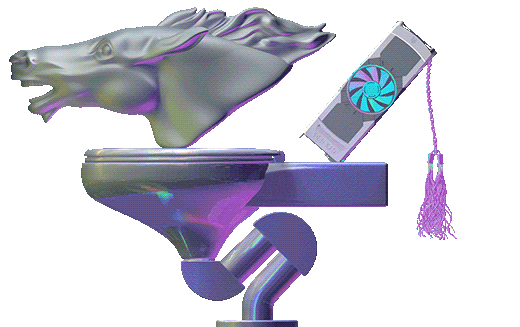

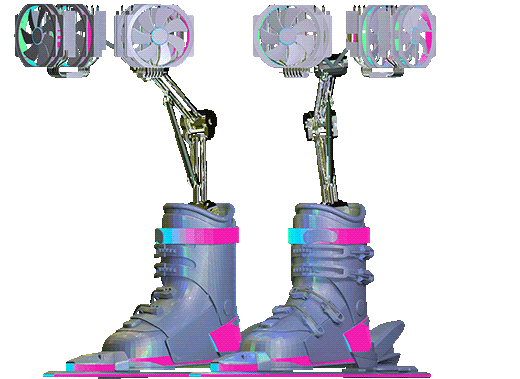
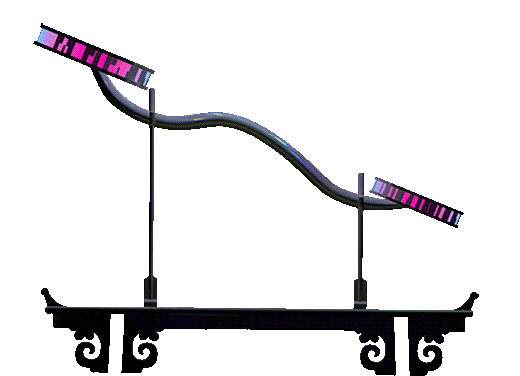

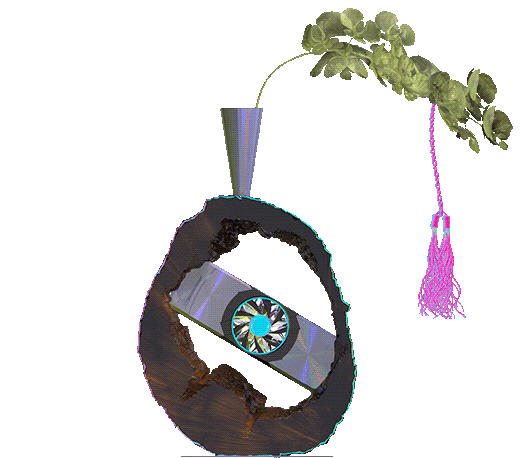
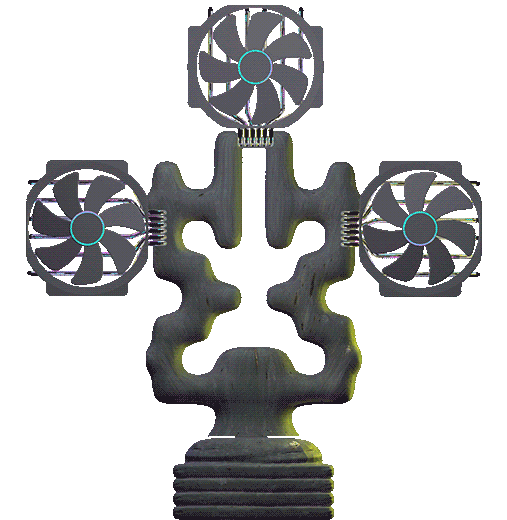
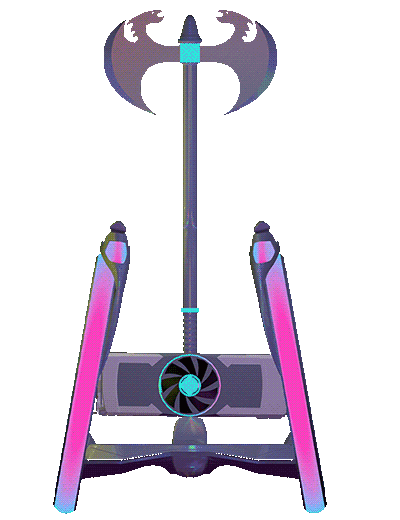

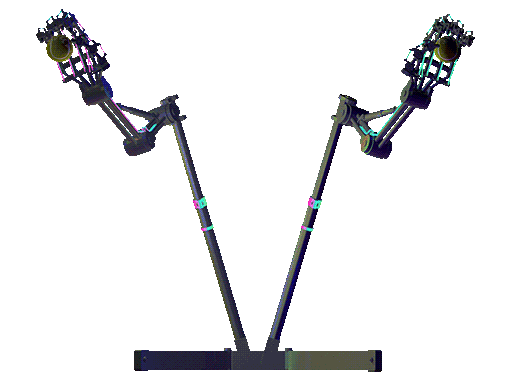
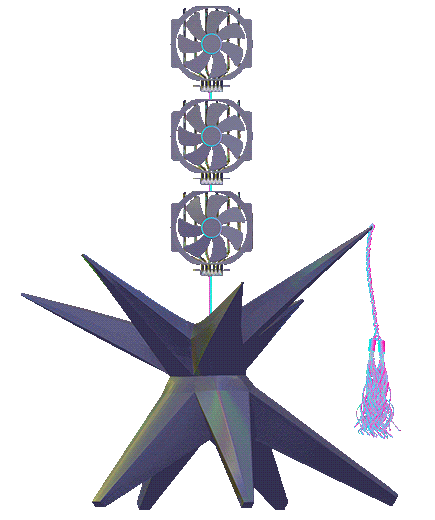
Fong Han-yu is a Health Aesthetician who has committed himself to the study and methodology of Virtual Health Preservation. Dr. Feng founded this school of thought in 1991, he has published numerous books and has invented a line of health cultivation sculptures beneficial for the mind and body. These sculptures combine traditional chinese theory and human-oriented technological innovations. Engage through the means of look, touch, appreciation and play, and improve the flow of qi through the tendons and muscles. These sculptures, placed in a suitable position at home can guide a prosperous flow of fengshui energy. Health cultivation sculptures are not confined in the virtual or the real; the virtual and the real are mutually generative, they can also be deposited on the internet. The sculptures are a blessing to modern day people who live a busy lifestyle.
*The content in this production are of artistic creation. No identification with actual persons (living or deceased) is intended or should be inferred.
鳳漢玉老先生,養生美學博士,於1991年始,醉心於研究「虛擬養生學」的本體與方法理論,為此學派的開創者與實踐者。鳳博士除著作豐沛,亦專注研發有助於身心靈之「養生雕塑」,積極將傳統理論融合人類高科技產物,強調觀、觸、賞、玩四相共構,觸之引暢筋脈氣血 ; 擺置
於適切之處亦可導引吉祥風水之氣。養生雕塑不侷限於虛實,虛實相生相轉,可存於網路,對於忙碌之現代人乃一大福音。
*以上內容純屬虛構,如有雷同純屬巧合。
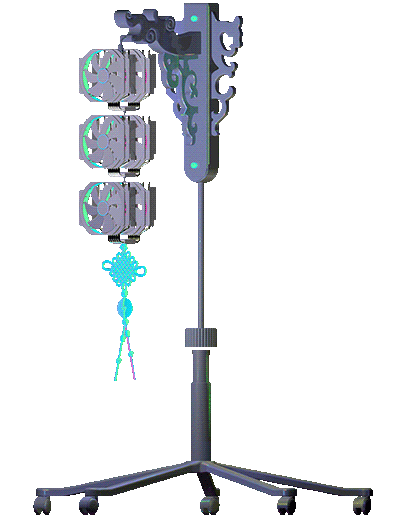
Virtual Feng Shui Statues*The content in this production are of artistic creation. No identification with actual persons (living or deceased) is intended or should be inferred.
鳳漢玉老先生,養生美學博士,於1991年始,醉心於研究「虛擬養生學」的本體與方法理論,為此學派的開創者與實踐者。鳳博士除著作豐沛,亦專注研發有助於身心靈之「養生雕塑」,積極將傳統理論融合人類高科技產物,強調觀、觸、賞、玩四相共構,觸之引暢筋脈氣血 ; 擺置
於適切之處亦可導引吉祥風水之氣。養生雕塑不侷限於虛實,虛實相生相轉,可存於網路,對於忙碌之現代人乃一大福音。
*以上內容純屬虛構,如有雷同純屬巧合。

FREE DOWNLOAD
☯ Fong Han-yu
Fong Han-yu immerses himself in the flow and clustering of images in mass media culture. Often working within social media platforms such as facebook, instagram, and tumblr, Fong's creative approach is often based on collecting images and creating fictional narratives. Each project is defined by a specific concern and set of rules that guide his process of assemblage. Through virtual projects such as Plantktonics, Happy Virtual Friend, Virtual Check-in, Peace and Happiness, Software 2050, Human observations, Fong attempts to
draw out new ways of seeing.
www.instagram.com/software2050
Fong Han-yu immerses himself in the flow and clustering of images in mass media culture. Often working within social media platforms such as facebook, instagram, and tumblr, Fong's creative approach is often based on collecting images and creating fictional narratives. Each project is defined by a specific concern and set of rules that guide his process of assemblage. Through virtual projects such as Plantktonics, Happy Virtual Friend, Virtual Check-in, Peace and Happiness, Software 2050, Human observations, Fong attempts to
draw out new ways of seeing.
www.instagram.com/software2050
Archive 2018_Training Core
We now have mastered
the ability to throw stones with empty hands
現在,我們已掌握了空手扔石頭的能力
Eteam (Hajoe Moderegger and Franziska Lamprecht)

Who knows the future of predictions? Will they be made by machines, our fortunes told by data? Techne, as it says in the dictionary we use, comes from the Greek: art, skill, cunning of hand. As in deceiving; craftiness; guile. adeptness in performance; dexterity.
Technology today connects Trillions. But what is that number in comparison to the relations the universe maintains? Relays. We meant to say: But what is that number in comparison to the relations the universe relays to those aware of what? Their bodies? Their being part of the isolation of bodies in space? What kind of space? What kind of body? Condensations in the void?
Lao Tzu says it is the empty part of the vessel that is the most useful. Shape hardware into Internet – is it our ability to throw stones with empty hands that is most useful?
We now can script that into forms of empty gestures. The user’s hand lost its cunning. Currently the cosmic dance is a protest, the cosmic apprentices are bearing witness on behalf of the Internet. We, the Internet protest. We, the Internet practice. We, the Internet are aware of being circled and looked upon from outside angles, being rummaged around in our scripts. Sometimes we do it ourselves. “Not knowing that one knows is best,” says Lao Tzu.
Running clock-wise. Back and forth within that rotation. Even empty space is curved and to adapt to that takes an expanded practice with a limited range of applicability. What bends the mind straightens the body. Intrinsic rhythm. Repeatedly, we say, we are standing upright on two feet and gesture outward. Repeatedly, we signal outward to draw attention to an inner state. In a frame of reference we move with respect to the observer. Relatively speaking, we represent.
未來會如何預測?由機器或數據來告訴我們趨勢嗎?在我們使用的字典中,Techne一詞源於希臘,意思是:藝術、技巧、巧手;欺騙;狡猾;詭計;表現熟練;靈巧。
今天的科技將億萬的人聯繫起來。但這個數字與宇宙的關係相比是什麼呢?轉換迴路(relay)。 我們的意思是:這個數字相比於宇宙迴路中所傳送的關係又是什麼?那些關係的接收者意識到了什麼?關係的體現?隔離身體的空間?什麼樣的空間?什麼樣的身體? 虛空中的凝結?
老子曾說,「埏埴以為器,當其無,有器之用。」[1] 將硬體塑造成網際網路 - 空手扔石頭的能力是否是最有用呢?
我們將以上的程序編寫為一種空手的姿勢。使用者的手失去了靈巧。此時此刻,宇宙的運動是一種抗議,宇宙的子弟代表網際網路見證。我們,身為網路,抗議。我們,身為網路,實踐。我們,身為網路,意識到我們正被包圍、盤旋、從外往內觀看,我們的程序遭到翻找。有時是我們自己這麼做。老子曰,「知,不知,上。」[2]
順應時鐘上的指針,在旋轉中來回運行,即使是空的空間也是彎曲的。要適應就必須在有限的應用範圍中擴展練習。拗折意識的東西拉直了我們的身軀。內在的節奏,我們反覆地說;雙腳站立,姿態向外,我們反覆地向外發出信號,召喚對內心狀態的注意。 在這框架中,我們相對觀察者的位置正在移動。 相對的說,我們是一種形象。
[1] https://ctext.org/dictionary.pl?if=gb&id=11602
[2] https://ctext.org/dictionary.pl?if=gb&id=11662
今天的科技將億萬的人聯繫起來。但這個數字與宇宙的關係相比是什麼呢?轉換迴路(relay)。 我們的意思是:這個數字相比於宇宙迴路中所傳送的關係又是什麼?那些關係的接收者意識到了什麼?關係的體現?隔離身體的空間?什麼樣的空間?什麼樣的身體? 虛空中的凝結?
老子曾說,「埏埴以為器,當其無,有器之用。」[1] 將硬體塑造成網際網路 - 空手扔石頭的能力是否是最有用呢?
我們將以上的程序編寫為一種空手的姿勢。使用者的手失去了靈巧。此時此刻,宇宙的運動是一種抗議,宇宙的子弟代表網際網路見證。我們,身為網路,抗議。我們,身為網路,實踐。我們,身為網路,意識到我們正被包圍、盤旋、從外往內觀看,我們的程序遭到翻找。有時是我們自己這麼做。老子曰,「知,不知,上。」[2]
順應時鐘上的指針,在旋轉中來回運行,即使是空的空間也是彎曲的。要適應就必須在有限的應用範圍中擴展練習。拗折意識的東西拉直了我們的身軀。內在的節奏,我們反覆地說;雙腳站立,姿態向外,我們反覆地向外發出信號,召喚對內心狀態的注意。 在這框架中,我們相對觀察者的位置正在移動。 相對的說,我們是一種形象。
[1] https://ctext.org/dictionary.pl?if=gb&id=11602
[2] https://ctext.org/dictionary.pl?if=gb&id=11662
☯ Eteam
Since 2001 eteam (Franziska Lamprecht and Hajoe Moderegger) traffic in transience. At the intersection of relational aesthetics, the Internet and land art, eteam coordinates collective happenings and conceptual transactions between the earthly plane and the realms of the interweb, often reconstructed in hypnotic video work, radio plays, or more recently novellas and novels. Their projects have been featured at PS1 NY, MUMOK Vienna, Centre Pompidou Paris, Transmediale Berlin, Taiwan International Documentary Festival, New York Video Festival, International Film Festival Rotterdam, the 11th Biennale of Moving Images in Geneva, among others.
meineigenheim.org
Since 2001 eteam (Franziska Lamprecht and Hajoe Moderegger) traffic in transience. At the intersection of relational aesthetics, the Internet and land art, eteam coordinates collective happenings and conceptual transactions between the earthly plane and the realms of the interweb, often reconstructed in hypnotic video work, radio plays, or more recently novellas and novels. Their projects have been featured at PS1 NY, MUMOK Vienna, Centre Pompidou Paris, Transmediale Berlin, Taiwan International Documentary Festival, New York Video Festival, International Film Festival Rotterdam, the 11th Biennale of Moving Images in Geneva, among others.
meineigenheim.org
Archive 2018_Training Core
STREAM AND DOWNLOAD
HB/AV AUDIO TRACKS
重呼吸練習錄音帶
HEAVY BREATHING
HB/AV is a series of artist-led movement seminars designed for audio/video download. The concept of HB/AV is the same as HB's workshop series: bringing together somatic exercises with critical discourse that might take the form of a lecture, a dialogue, a guided meditation, and/or other modes of experimental and performative texts - basically “Heavy Breathing on the Go”.
HB/AV為線上推出的運動研討會錄像和錄音帶,提供線上收聽與下載。內容包括講座、對話、引導式冥想、和其他實驗性、表演性文本。提倡一種機動形的「重呼吸」練習。
HB/AV為線上推出的運動研討會錄像和錄音帶,提供線上收聽與下載。內容包括講座、對話、引導式冥想、和其他實驗性、表演性文本。提倡一種機動形的「重呼吸」練習。

Chani Bockwinkel
SAPPHO and SWEAT 薩福與汗水
(2018, 23:06)
A luxurious and sweaty strange dance class to perform alone in your room. A thunderfuck of somatics, athletics and the burning words of Sappho's poetry.
"...that loosener of limbs, bittersweet creature against which nothing can be done.” — Sappho
在你的房間裡,獨自進行一場豪華、汗流浃背的奇特舞蹈課。
雷擊般的體操運動、與薩福詩歌中的灼熱之詞。
「...那令四肢鬆懈的、苦樂參半的動物,再它面前無法做任何抵抗。」-薩福。
A luxurious and sweaty strange dance class to perform alone in your room. A thunderfuck of somatics, athletics and the burning words of Sappho's poetry.
"...that loosener of limbs, bittersweet creature against which nothing can be done.” — Sappho
在你的房間裡,獨自進行一場豪華、汗流浃背的奇特舞蹈課。
雷擊般的體操運動、與薩福詩歌中的灼熱之詞。
「...那令四肢鬆懈的、苦樂參半的動物,再它面前無法做任何抵抗。」-薩福。
Readings:
Anne Carson, If Not Winter, Fragments of Sappho
Tom Meyers, Anatomy Trains
Irene Dowd, Taking Root to Fly
Mary R. Lefkowitz,
Women in Greek Myth
Anne Carson, If Not Winter, Fragments of Sappho
Tom Meyers, Anatomy Trains
Irene Dowd, Taking Root to Fly
Mary R. Lefkowitz,
Women in Greek Myth
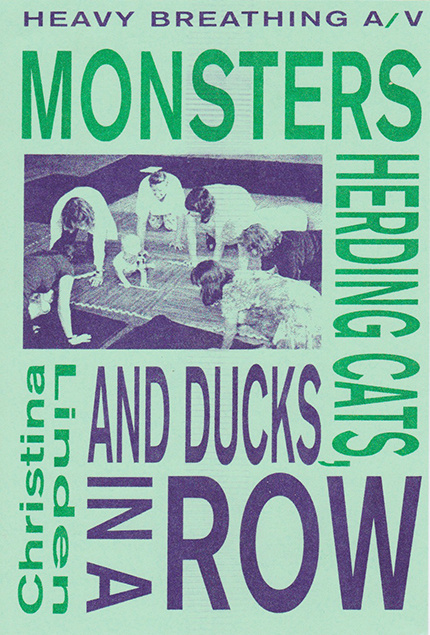
Christina Linden
Monsters Herding Cats, and Ducks In A Row
怪物放牧貓,鴨子站一排
(2018, 10:00)
Audio guide for a session of stretching, rolling, crawling, and light contact improv for adults and their baby or toddler friends. Readings of selected excerpts from children's books and Moyra Davey's Mother Reader. Bring your own music.
適合成人、嬰兒、和幼兒朋友們的語音導覽,內容包括拉伸、滾動、爬行、輕量的接觸即興活動、以及摘自莫伊拉 · 戴維的母親讀本、兒童書籍的文本閱讀。請配上你自己選擇的音樂。
Audio guide for a session of stretching, rolling, crawling, and light contact improv for adults and their baby or toddler friends. Readings of selected excerpts from children's books and Moyra Davey's Mother Reader. Bring your own music.
適合成人、嬰兒、和幼兒朋友們的語音導覽,內容包括拉伸、滾動、爬行、輕量的接觸即興活動、以及摘自莫伊拉 · 戴維的母親讀本、兒童書籍的文本閱讀。請配上你自己選擇的音樂。
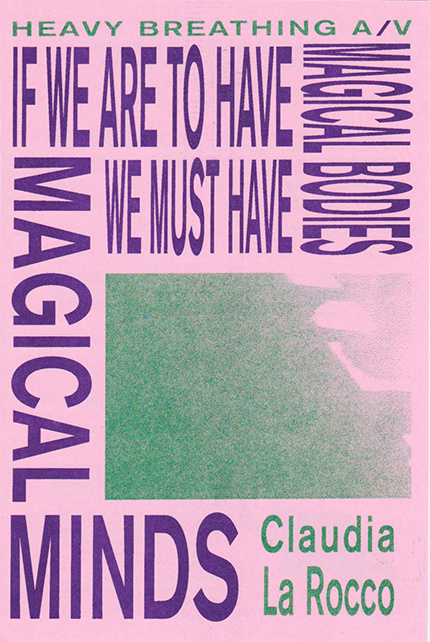
Claudia La Rocco
If we are to have magical bodies
we must have magical minds
如果我們要擁有神奇的身軀,我們必須擁有神奇的頭腦
we must have magical minds
如果我們要擁有神奇的身軀,我們必須擁有神奇的頭腦
(2018, 18:40)
This is a somewhat condensed version of my contribution to the Heavy Breathing series, which I performed at the UC Berkeley Art Museum and Pacific Film Archive in 2017. It is a splice of my two practices, shuttling between very different or maybe very similar modes: my writing, and my teacher’s notes.
Some of the writing is new and some of it is previously published; some of the notes are edited, and some are not.
2017年,我在加州大學伯克利分校藝術博物館和太平洋電影資料館進行了兩次重呼吸系列活動。此音檔為實體活動的濃縮版,穿梭於兩個截然不同、也或許非常相似的創作模式之間:我的個人寫作和教學筆記。部分寫作是新的,其中以前發表過;有些筆記是經過編輯的,有些不是。
This is a somewhat condensed version of my contribution to the Heavy Breathing series, which I performed at the UC Berkeley Art Museum and Pacific Film Archive in 2017. It is a splice of my two practices, shuttling between very different or maybe very similar modes: my writing, and my teacher’s notes.
Some of the writing is new and some of it is previously published; some of the notes are edited, and some are not.
2017年,我在加州大學伯克利分校藝術博物館和太平洋電影資料館進行了兩次重呼吸系列活動。此音檔為實體活動的濃縮版,穿梭於兩個截然不同、也或許非常相似的創作模式之間:我的個人寫作和教學筆記。部分寫作是新的,其中以前發表過;有些筆記是經過編輯的,有些不是。
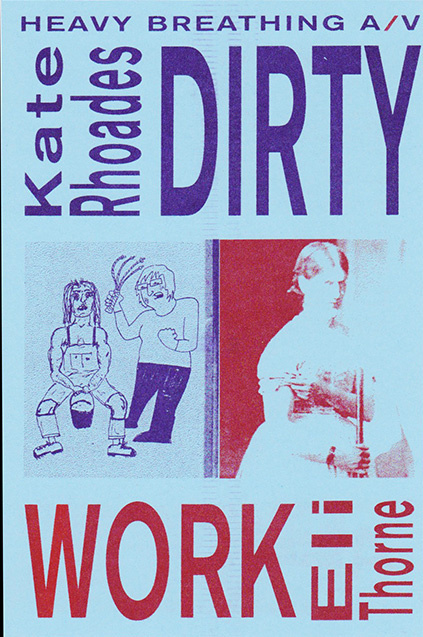
Kate Rhoades + Eli Thorne
Dirty Work 熱活
(2018, 22:11)
We lead couples in a strength training workout based on a chapter from Ann McClintock's book, Imperial Leather which investigates gender, violence, class, and BDSM in Victorian England. Participants will take turns being submissive or dominant and get dirty while building muscle.
Special thanks to Stephanie Ellis.
我們帶領情侶進行體能訓練,內容起源於安 · 麥克克林托克的著作「帝國皮革」裡其中一章,調查維多利亞時代英格蘭有關性別、暴力、階級和BDSM的歷史。 參與者將輪流擔任順從或主導的角色,在熱情的運動中增長肌力。
特別鳴謝 史提芬妮 · 艾利斯。
We lead couples in a strength training workout based on a chapter from Ann McClintock's book, Imperial Leather which investigates gender, violence, class, and BDSM in Victorian England. Participants will take turns being submissive or dominant and get dirty while building muscle.
Special thanks to Stephanie Ellis.
我們帶領情侶進行體能訓練,內容起源於安 · 麥克克林托克的著作「帝國皮革」裡其中一章,調查維多利亞時代英格蘭有關性別、暴力、階級和BDSM的歷史。 參與者將輪流擔任順從或主導的角色,在熱情的運動中增長肌力。
特別鳴謝 史提芬妮 · 艾利斯。

Tom Comitta
Born to Run 生來就是要奔跑的
(2018, 45:34)
Thank you to Sophia Wang and Lisa Rybovich Crallé for creating a space and context for this piece. For more information on literary supercuts — mine and others — check out this conversation between me and Jez Burrows published by The Believer in May 2018: https://logger.believermag.com/post/comitta-burrows
Born to Run is an audio chapbook that collages descriptions of running and jogging from over 60 novels. There's everything in here from Stephen King's The Running Man to Cynthia Voigt's The Runner, with a sprinkling of Charles Dickens, Agatha Christie and Samuel R. Delany. To experience this piece, a listener would get on a treadmill, elliptical or any artificial exercise device, put on headphones and press play.
感謝Sophia Wang 和 LisaRybovichCrallé為這件作品創造的場域和語境。
有關此項目的更多文學精選 - 自我和其他作者 - 請查閱2018年5月由The Believer出版訪談: https://logger.believermag.com/post/comitta-burrows
「生來就是要奔跑的」是一段語音章節,拼貼60多部小說中跑步和慢跑的描述。 涵蓋的著作有斯蒂芬 · 金的過關斬將和辛西亞 · 佛特的跑者,其中包括查爾斯 · 狄更斯、阿加莎 · 克里斯蒂和塞繆爾 R.德拉尼。以體驗這件作品,請站上跑步機,滑步機或任何人工運動裝置,隨著肢體的運動,戴上耳機並按播放。
Thank you to Sophia Wang and Lisa Rybovich Crallé for creating a space and context for this piece. For more information on literary supercuts — mine and others — check out this conversation between me and Jez Burrows published by The Believer in May 2018: https://logger.believermag.com/post/comitta-burrows
Born to Run is an audio chapbook that collages descriptions of running and jogging from over 60 novels. There's everything in here from Stephen King's The Running Man to Cynthia Voigt's The Runner, with a sprinkling of Charles Dickens, Agatha Christie and Samuel R. Delany. To experience this piece, a listener would get on a treadmill, elliptical or any artificial exercise device, put on headphones and press play.
感謝Sophia Wang 和 LisaRybovichCrallé為這件作品創造的場域和語境。
有關此項目的更多文學精選 - 自我和其他作者 - 請查閱2018年5月由The Believer出版訪談: https://logger.believermag.com/post/comitta-burrows
「生來就是要奔跑的」是一段語音章節,拼貼60多部小說中跑步和慢跑的描述。 涵蓋的著作有斯蒂芬 · 金的過關斬將和辛西亞 · 佛特的跑者,其中包括查爾斯 · 狄更斯、阿加莎 · 克里斯蒂和塞繆爾 R.德拉尼。以體驗這件作品,請站上跑步機,滑步機或任何人工運動裝置,隨著肢體的運動,戴上耳機並按播放。

Christian Nagler
(2018, 22:28)
In this session we will delve deeply into some embodied non-solutions to the problem of global risk management. What are global risk management practices and how do they relate to our nervous systems? Listen, follow along and engage in an athletic and de-armoring session of Reichian somatics, full-corpus spasms, and galactic tingles. Wear comfortable clothes. Prepare to move, breathe intensely, yell, and freak out a little.
Performer Bios
Amelia Charter is an artist, performer and teacher living in Los Angeles.
Kevin Nagler is an artist currently located in Abiquiu, New Mexico
Susannah Schoff is a teacher who lives in Alameda, CA
COSMOCONVULSIVE ANXIOTHENICS
宇宙抽搐焦慮體操
(2018, 22:28)
In this session we will delve deeply into some embodied non-solutions to the problem of global risk management. What are global risk management practices and how do they relate to our nervous systems? Listen, follow along and engage in an athletic and de-armoring session of Reichian somatics, full-corpus spasms, and galactic tingles. Wear comfortable clothes. Prepare to move, breathe intensely, yell, and freak out a little.
Performer Bios
Amelia Charter is an artist, performer and teacher living in Los Angeles.
Kevin Nagler is an artist currently located in Abiquiu, New Mexico
Susannah Schoff is a teacher who lives in Alameda, CA
Readings:
1. Ulrich Beck, Living in the World Risk Society, 2006
2. Michel Foucault, Security Territory, Population, Lectures at the College de France, 1979 (especially lecture no. 2)
3. Benjamin Lee and Edward Lipuma, Circulatory Risks and the Speculative Habitus
4. Dusan Makavejev, WR: Mysteries of the Organism, 1971
5. Wilhelm Reich, The Mass Psychology of Fascism, 1933 and Character Analysis, 1933
6. Claire Souch, Pushing the Boundaries of Catastrophe Modeling, 2014
7. Peter A. Levine Nature's Lessons in Healing Trauma
一場關於全球風險與身體的神經系統對話,內容包括肌肉放鬆、全語境痙攣以及來自遙遠星系的腦內刺激。
克里斯汀 · 納格爾近年來持續對矽谷的表演文化進行人類學研究,創作錄像作品Shoulder Babies,並籌辦一個命名為phoebe的組織。寫作曾發表於 TDR、Performance Research、Art Practical,2016年出版書籍「人力資本:生命」。
☯ Heavy Breathing
Heavy Breathing is a series of experimental movement seminars designed by artists combining physical activity with group discussion on ideas related to their creative practice. Critical thinking often feels heady, abstract, and divorced from the body. How do conversations change when we are moving our bodies and out of breath? What new modes of thinking become possible?
heavyheavybreathing.com
Heavy Breathing is a series of experimental movement seminars designed by artists combining physical activity with group discussion on ideas related to their creative practice. Critical thinking often feels heady, abstract, and divorced from the body. How do conversations change when we are moving our bodies and out of breath? What new modes of thinking become possible?
heavyheavybreathing.com
This series of drawings on paper depict clear contoured images that express an intimacy between one and one’s domestic world. Through original perspective and style, the work is a limitless creation made under limited conditions. Drawings is some kind of ritual or habit that begins by defining all the frames; in these spaces, I place bodies, objects and emotionally existing utopias and discover a gap in time-space where the closedness of reality opens into a boundlessness--where I explore the relationship between reality and illusion.
Searching for intangible materials in a fixed, defined world, Sun’s Shadow opens up a wide vision where the self is continually thrown out; viewers are encouraged to free themselves from the usual limitations and explore a greater imagination; to excavate an implied existence beyond the physical.
此系列主要通過紙張素描,以線條明確的畫面,呈現自身與所居住世界的親密感,並具以獨特的視角和表現風格,在被限制的前提下做無限制的創作。如同其大多的創作出於某種儀式或是習慣,總先將所有的外框先畫出,透過繪畫的過程,表達人體、物件、情感存在的烏托邦,在被限制的空間中,卻得以尋獲時空的間隙,展現封閉空間的無限,進而探討現實與虛幻的關係,意欲從已既定的世界觀中進一步探察看不見的物質,《太陽影子》進而敞開更大的視野,將自我不斷的拋出,使觀者屏除固有的限制,開拓更多的想像,考掘實體之外那隱誨的存在。
Searching for intangible materials in a fixed, defined world, Sun’s Shadow opens up a wide vision where the self is continually thrown out; viewers are encouraged to free themselves from the usual limitations and explore a greater imagination; to excavate an implied existence beyond the physical.
此系列主要通過紙張素描,以線條明確的畫面,呈現自身與所居住世界的親密感,並具以獨特的視角和表現風格,在被限制的前提下做無限制的創作。如同其大多的創作出於某種儀式或是習慣,總先將所有的外框先畫出,透過繪畫的過程,表達人體、物件、情感存在的烏托邦,在被限制的空間中,卻得以尋獲時空的間隙,展現封閉空間的無限,進而探討現實與虛幻的關係,意欲從已既定的世界觀中進一步探察看不見的物質,《太陽影子》進而敞開更大的視野,將自我不斷的拋出,使觀者屏除固有的限制,開拓更多的想像,考掘實體之外那隱誨的存在。
☯ Son Ni
I can make things disappear and I can make things reappear. By things I mean anything, even people, but I have a soft heart and it makes things difficult. I memorize these things before I vanish them, in case I may regret someday. If I don't remember them, no one else will.
Son Ni, Born 1984 in Taipei, Son Ni is mainly engages in drawing, painting, and art publishing. She founded independent publishing house nos:books in 2008 and mini mobile art space The Calabash Gallery in 2014.
deadtreeopenflower.com
www.nosbooks.com
I can make things disappear and I can make things reappear. By things I mean anything, even people, but I have a soft heart and it makes things difficult. I memorize these things before I vanish them, in case I may regret someday. If I don't remember them, no one else will.
Son Ni, Born 1984 in Taipei, Son Ni is mainly engages in drawing, painting, and art publishing. She founded independent publishing house nos:books in 2008 and mini mobile art space The Calabash Gallery in 2014.
deadtreeopenflower.com
www.nosbooks.com
